Learn how to make delicious overnight sourdough bread at home with a step-by-step video that’s perfect for the beginner and that your family will love.
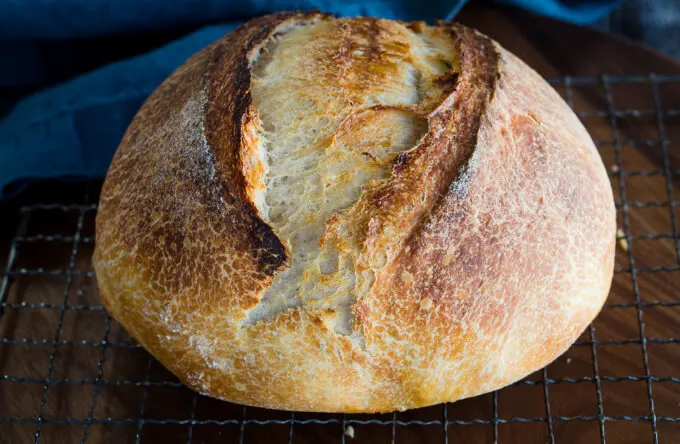
Overnight Sourdough Bread recipe is the perfect recipe to learn baking with a sourdough bread starter. Our step-by-step instructions and video will have you creating an amazing loaf of bread at home in no time.
This Sourdough Bread recipe couldn’t be easier to make and it’s a lot quicker compared to other sourdough bread recipes from starters.
This 500g homemade sourdough recipe has a tender crumb with a slightly sour flavor surrounded by a beautiful crisp crust that has that pull you want in artisan bread.
Sourdough Bread had been on this list for 3 years! I let uncertainty and trepidation keep me from jumping on the Sourdough Bread bandwagon. How can Bread and water be intimidating? Right?
Participating in an online monthly bread challenge finally pushed me into trying sourdough, and the rest is history.
I was fortunate enough to receive some dried starter from a wonderful woman named Selma. Selma passed away a few years ago but her blog “Selma’s Table” still remains and I consult it often. This is a recipe that I got from her blog.
She named her starter “Twinkle” and encouraged everyone to name theirs too. My starter’s name is “Phoenix” because she rose from dust. She has amazing vigor. I’m not always vigilant about keeping her fed but she doesn’t hold it against me and rises to the occasion every time.

I’ve included photos of my 1st loaf and a recent one at the end of this post. I’m proud of both and hope you’ll try this basic sourdough bread recipe too.
Hello, Julie. Just wanted to say thank you for sharing your overnight sourdough recipe as it really works well for me, a lot of people have shared their methods and this one is simply the best one I have come across so far. So thank you again!”
Kris T
What is Sourdough Bread
Sourdough bread is made by fermentation of dough using naturally occurring lactobacilli and yeast. Sourdough bread has a mildly sour taste not present in most bread made with baker’s yeast and keeps better than other bread due to the lactic acid produced by the lactobacilli. Wikipedia
What is different about sourdough bread?
The difference is in how they are made. Regular bread is made using store-bought yeast that reacts with gluten making the dough rise. Sourdough bread is made with a “starter“. This starter is made from a combination of yeast and bacteria growing inside a paste made of flour and water.
Make your own starter!
If you have questions on making or using a Bread Starter, read “How To Make Your Own Bread Starter (and how to maintain it).”
Health Benefits of Sourdough bread
The fermentation that occurs from using a starter has been shown to lower blood sugar, be easier to digest and can even be tolerated by gluten resistant individuals.
However, that’s not to say it is gluten-free. Sourdough bread contains higher levels of folate and antioxidants than other bread. Healthline is a very thorough reference regarding the health benefits of sourdough.
Ingredient Tips:
- Bubbly starter – I recommend feeding your starter and letting it sit out at room temperature 4 to 6 hours or until it increases in volume by about 30% and passes the float test.
- If your dough is runny it can be because your starter was actually starving when you used it.
- Bread Flour – Bread flour has a higher protein content than AP flour. That higher protein provides more structure to your loaf.
- If you substitute they will both be delicious and the texture will be the same but you may find the loaf made with AP flour balloons out more or doesn’t rise as high.
- Water – There’s a lot of controversy regarding water in bread making. Some experts say if you can drink it you can use it to bake with. Other experts say the chlorine can inhibit yeast activity.
- Mineral content (hardness) can reduce extensibility (elasticity and ability to stretch) of the dough.
- Salt – I use fine sea salt. It is easier to incorporate and dissolve than coarser salt.
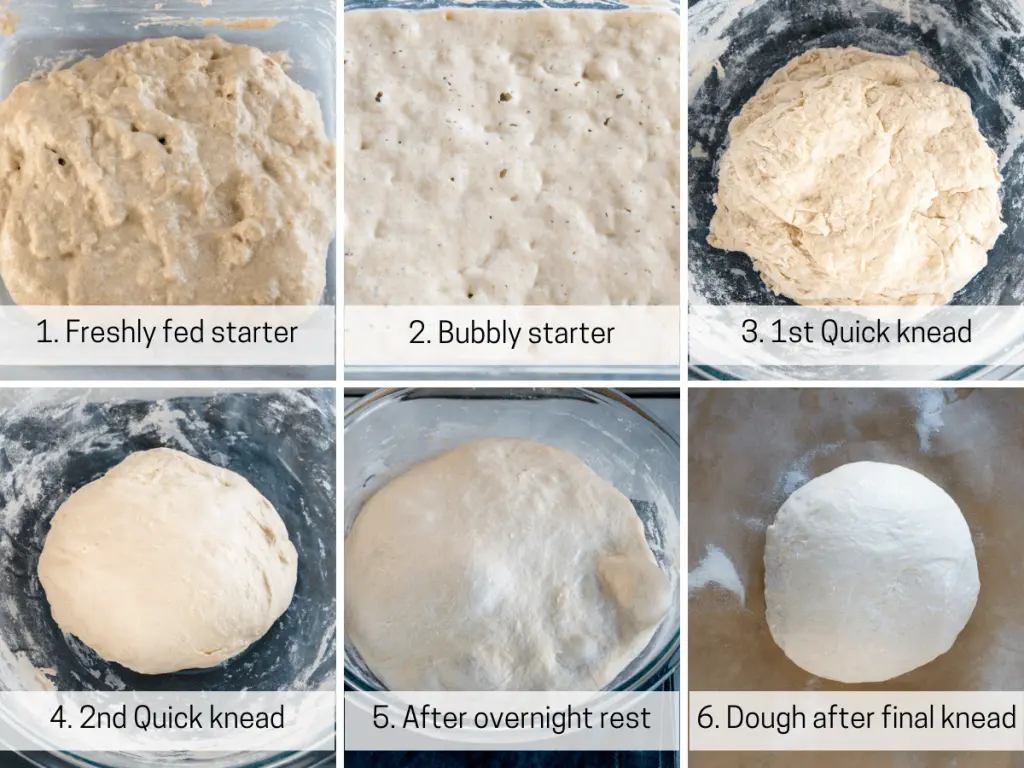
The above pictures from top left to bottom right.
- The freshly fed starter is thick.
- The Bubbly starter is ready. when bubbly and passes the float test.
- 1st quick knead just to combine ingredients (about 1 minute). The dough is thick and heavy.
- 2nd quick knead after a 30-minute rest. The dough is softer and smoother.
- Dough after 8 hours is full of air bubbles.
- Dough after final delicate knead is smooth and silky.
Absolutely! We love adding dried fruit such as apricots or cranberries, chopped nuts, cheese, olives, or herbs such as rosemary or thyme.
We recommend that you start by adding no more than 20%. So for this 500-gram loaf that would be
500 x 20% = 100 grams. You shouldn’t have to adjust your baking time.
Be careful that you don’t add a lot of moisture. Semi-hard cheeses such as cheddar shredded or diced into smaller pieces work well. Drain fresh fruit or olives of excess juice.
Recipes using a bread starter
- Multi-Grain Wheat Bread Recipe
- Spelt Sourdough Bread
- Sourdough Sandwich Bread using Bread Starter
- Multi-Grain Wheat Bread
- 750gr All-Purpose Flour Sourdough.
Pro tips for Overnight Sourdough Bread
Resting times
Don’t let bread rule your life! Here are some resting times that may help you to bake according to your schedule
- Counter rise – Written as is, this recipe has a counter rise of 6 to 8 hours. You shape it and then bake it. This time is variable. If you have a very warm kitchen it may be ready sooner. Press your thumb into the dough and if it bounces back slowly it’s ready to bake. If it’s over-proofed, it will be very difficult to shape.
- Refrigerator proofing – If you don’t choose to bake your bread at the 6 to 8 hour counter proof, we recommend a 90 minute to 4 hour counter proof. Shape the dough and place it seam-side up into a banneton basket or a bowl lined with a kitchen towel that’s dusted with flour. We like dusting ours with a 50/50 mix of wheat flour and rice flour. We’ve actually left our bread in the refrigerator for up to 18 hours with no problems.
- When you’re ready to bake, remove the shaped dough from the refrigerator and let it sit on the counter while your oven preheats. Place it in the dutch oven, score it, and bake as usual.
If you do the full counter proof and then refrigerate the dough it will be over-proofed. For that reason, try a much shorter counter rise and then refrigerate it.
More helpful tips
- Feed your starter earlier in the day. When it’s bubbly do the test float. If it’s runny it’s used up all its energy and needs to be fed again before you can use it. To see if your starter is ready, put a small amount in a bowl or cup of water. If it floats it’s ready!
- Your bread can be cooked in a cold dutch oven but I like the color and rise I get from preheating my lidded pot.
- This bread freezes beautifully. I wrap it in plastic wrap or a ziplock bag and then heavy-duty foil.
- Each time you bake, we keep a notebook and write down anything we do differently such as resting time, baking time, or adding additional ingredients. It’s so difficult to remember what worked the best unless we can look back and see what we were happy about or wanted to do differently the next time. This will also help you to determine what resting times work for you.
YOU MAY NEED
The following are affiliate links. Hostess At Heart is a participant in the Amazon Services LLC Associates Program, an affiliate advertising program designed to provide a means for us to earn fees by linking to Amazon.com and affiliated sites. You can read my full disclosure.
Lodge 6 Quart Enameled Cast Iron Dutch Oven. Classic Red Enamel Dutch Oven (Island Spice Red) – I love this dutch oven. I have three that are triple the price of this one and it’s my favorite. It bakes my bread perfectly and makes a mean ragu recipe.
Zatoba 1003 Black Walnut Bread Lame Decorative Dough Slasher, 2x2x8 inches – I started out with a lesser quality lame and while this one isn’t expensive it’s definitely better quality and has made a prettier slash in my dough. It’s amazing
I have two books (out of several) that I’ve learned so much from. I recommend them exclusively to help in your bread experience. They are easy to read and will help you get that beautiful loaf on the table!
This is a 500gr loaf of bread which isn’t large. Baking bread is all about percentages. If you want a larger loaf, you can adjust the “Servings” in the recipe card and it will calculate your ingredients. (Thank you, Daniel, for this question!)
Conversions are listed below the recipe card
Conversions for Overnight Sourdough Bread recipe
We realize that many of you aren’t comfortable using a scale. The closest conversions are the following.
- 4 cups flour
- 1 1/4 cup water
- 2/3 cup starter
- 1 1/2 tsp salt
A disclaimer is that I’ve never made this recipe without weighing the ingredients so I can’t guarantee or possibly troubleshoot any problems you may have with the recipe.
If you like this recipe you may enjoy these too
- Homemade Crusty Bread recipe
- 6 Ingredient Simple Classic Italian Bread Recipe
- Soft Buttermilk Sandwich Bread
- Simple Ciabatta Bread Recipe – Made 2 Ways!
- Spiced Apple Star Bread
This bread was made possible by the resources and recipes shared by Elaine, Selma, and Celia! Please visit all three of these blogs for amazing bread information!
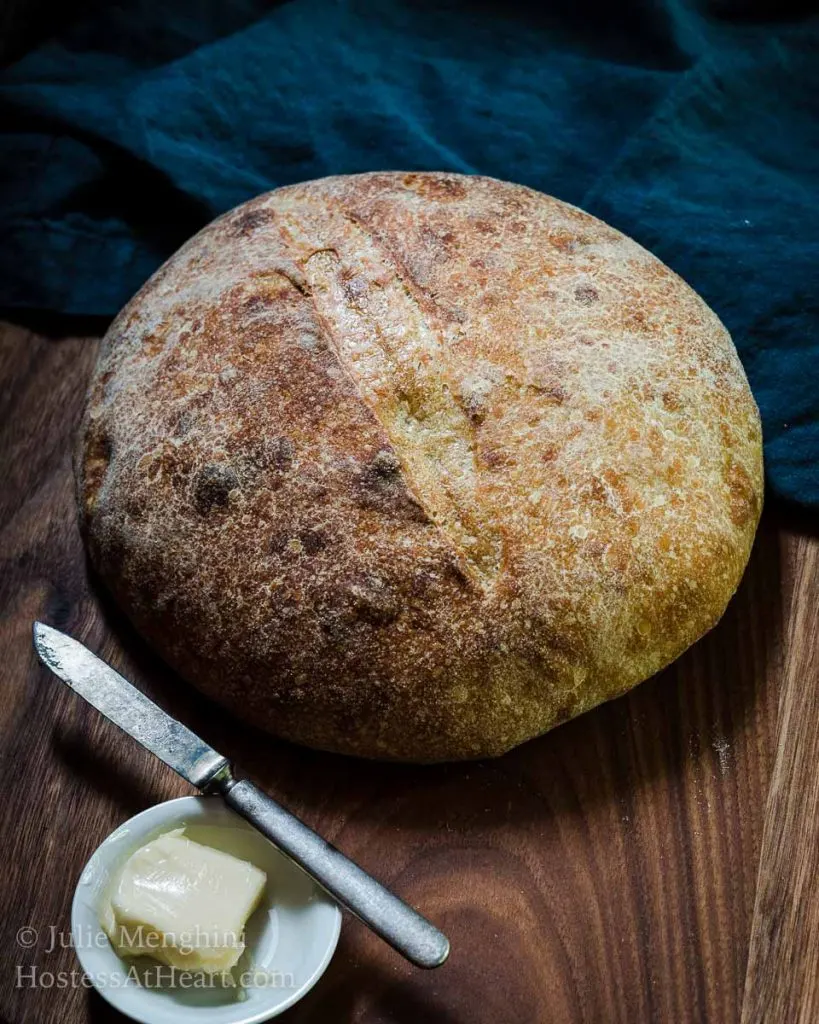
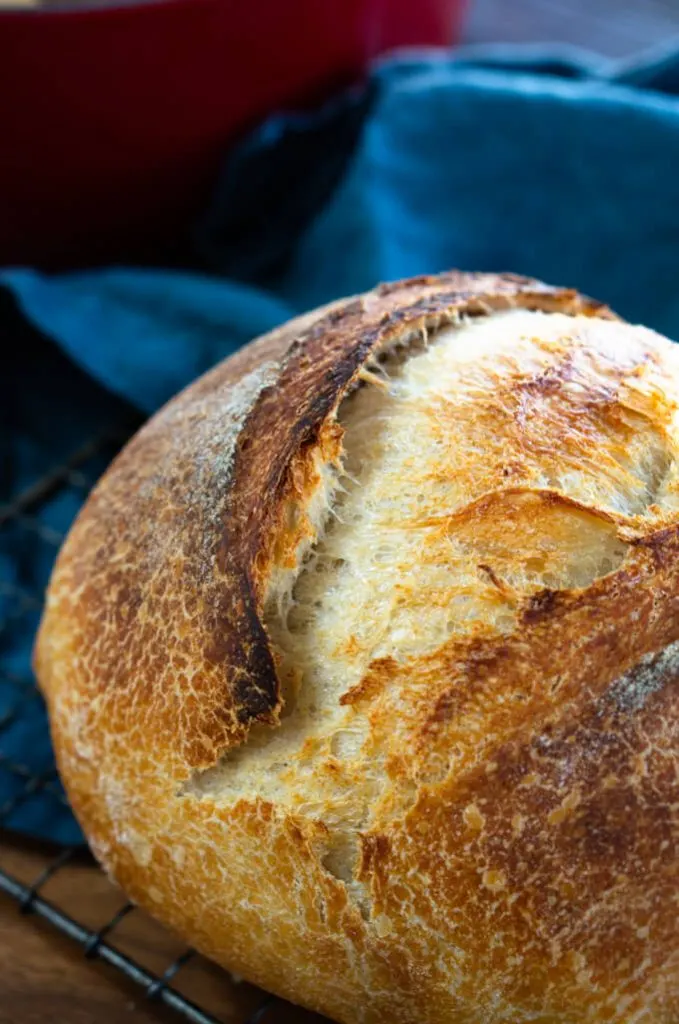

Did you enjoy this recipe? Don’t forget to pin it for later and follow me on Pinterest for more delicious recipes like this one!


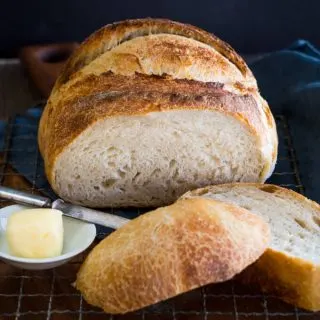

James
Monday 22nd of July 2024
LOVE LOVE THIS RECIPE! I do it exactly as you post. How do I keep the bottom from getting a little over-done? Seems a bit black in some areas? I have heard put the dutch oven in a cookie sheet? Any suggestions? Otherwise its perfect!
Julie Menghini
Monday 22nd of July 2024
I've seen that happen James if the pan is thinner aluminum? I use enameled cast-iron. I've also heard of people having luck using the cookie sheet under the dutch oven. Try that first and let me know how it goes.
Karen Kissinger
Wednesday 10th of July 2024
My first attempt at sourdough was not great. I used your recipe for my second attempt and it came out perfect!! Can’t wait to cut into it after it cools. Looking forward to making some jalapeño cheddar bread next.
Julie Menghini
Wednesday 10th of July 2024
That's awesome Karen! That just warms my heart. I love sourdough and how it fits into families and our memories. Oh, and it makes great gifts.
Kathy de Potter
Wednesday 26th of June 2024
Thank you so much for this recipe. The first time my bread looks like a sourdough bread. Let it sit on the counter for 6h. It was very hot here today. Next time going to try in the fridge. Your instructions are top. Greetings from Belgium
Kathy de Potter
Saturday 29th of June 2024
I shaped it but I think I needed to let it sit on the counter a bit longer. The one I made today, I let it rest 7h on the counter. It was so great. All bubbles and great to shape
Kathy de Potter
Saturday 29th of June 2024
Hi Julie, my 2nd loaf that was in the fridge overnight was not great. I got a 3th out of the oven and it is a beauty. I let it rest on the counter for 7h. I love my Dutch oven. Have a great weekend!!
Kathy de Potter
Thursday 27th of June 2024
@Julie Menghini, thank you, 2nd loaf is now resting and going in the fridge overnight. I also purchased a Dutch oven so I hope to see a difference with my open bake.
Julie Menghini
Wednesday 26th of June 2024
Thank you, Kathy from Belgium! I'm so glad that this recipe worked for you. Even with a lot of baking, this is my go-too for sourdough. I appreciate you stopping by with your process. The weather can really make a difference.
Elle
Saturday 15th of June 2024
Turned out great even though I was worried because dough was wetter & sticky more then usual. Dud jot cold proof at all. Left in microwave with door open so lightbulb gave warmth ( house cold).
Tastes great, but it is a very tiny loaf. Which I could attach picture. I would double recipe next time.
Julie Menghini
Sunday 16th of June 2024
That's odd Elle that your loaf was sticky and small? It's almost like it didn't proof?
Asya
Saturday 8th of June 2024
First off, I‘m from Germany so I loved that this recipe listed the ingredients in grams and the temperature in celsius.
This recipe turned out absolutely amazing! I have tried it multiple times now and really love the crust and the mild flavor of the bread. I do have to say that I left the dough in the fridge for about 16 hours the first time and that was definitely too long for me, the dough was overproofed. When I tried it again, I left it in the fridge for about 10 hours, and it turned out wonderful. Definitely my new go-to recipe!
Julie Menghini
Sunday 9th of June 2024
Hello to Germany, Asya! Thank you so much for your review and 5 stars! I've got to say that it's pretty much my go-to recipe as well.